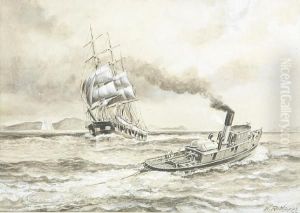Harry Ryle Hopps Paintings
Harry Ryle Hopps was an American illustrator and poster artist, recognized for his persuasive and patriotic works during World War I. Born in 1889 in San Francisco, California, Hopps pursued an artistic career that was deeply influenced by the socio-political events of his time. He is most noted for his contribution to the visual culture of wartime America, particularly through his work as a poster artist, where he employed striking imagery and bold messages to bolster support for the war effort.
Hopps began his career as an illustrator and cartoonist, working for various newspapers and magazines. His early work already demonstrated a keen eye for detail and a distinctive style that would later define his war posters. As the United States entered World War I, Hopps's art took a decidedly patriotic turn, focusing on themes of nationalism, sacrifice, and unity. He was among a group of artists who were commissioned by the U.S. government and private organizations to produce propaganda material aimed at boosting enlistment, selling war bonds, and promoting other wartime initiatives.
One of his most famous posters, 'Destroy This Mad Brute - Enlist,' depicts a monstrous gorilla, symbolizing Germany, invading the shores of America with a club in one hand and a helpless maiden in the other. This image, among others created by Hopps, played a significant role in shaping public opinion and rallying American support for the war. His ability to communicate complex messages through compelling visuals made him a key figure in the U.S. propaganda efforts during this period.
Despite his prominence during the war years, details about Hopps's life after World War I are less well-documented. He continued to work as an artist, but his later career did not achieve the same level of recognition as his wartime contributions. Harry Ryle Hopps passed away in 1944, leaving behind a legacy defined largely by his impactful war posters. His work remains an important part of the history of American graphic design and propaganda, illustrating the power of visual art to influence society and politics.
